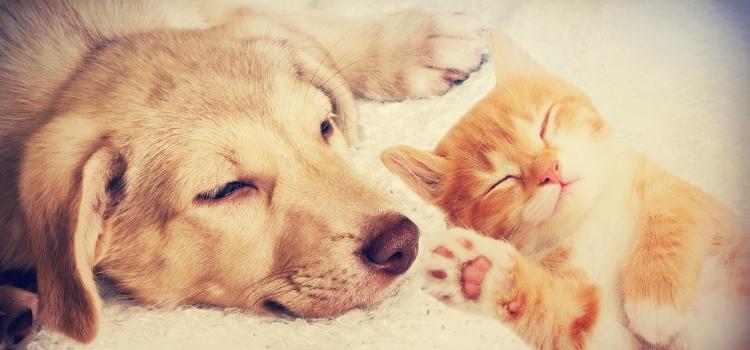Consumer Tips
New Pet Checklist
During the holidays many people add a new furry family member to their household. If you find yourself with a new pet this season, make sure the basics are covered by including these 7 must-haves on your checklist!

- Food
Choosing a food that’s appropriate for your new pet can be overwhelming. With hundreds of brands available, it can be difficult to sort through all of the options for a good pet food. Be sure to choose a diet that is consistent with your new pet’s age and size. For example, a 6 month old Chihuahua should eat a small breed puppy food, while an 8 year old Great Dane should eat a giant breed senior formula. Be sure that your pet’s new food contains an AAFCO feeding statement – this means that the food has been scientifically tested and proved to be healthy! Ask your veterinarian for a recommendation on the best foods available and remember, while cheap foods tend to be poor quality, the most expensive food isn’t always the best. - Bedding
Your new pet will need a place to safely and comfortably rest after a long day of playing. If you plan to allow your new pet on the bed and sofa, they may not need their own bed as they will surely prefer yours! However, pets who will sleep in a crate at night or on the floor need an appropriately sized bed. Make sure that the bed is large enough for them to sprawl out comfortably and made from soft padding. Beds need to be washed, so a machine-washable fabric is best.
- Crate or Carrier
New cats and kittens will need a carrier to safely transport them from the house to the veterinary office. New Puppies and dogs often need a crate as a safe place to sleep at night and when left alone at home. Crating your new puppy or dog will keep him safe from chewing on electrical cords, getting into toxic foods and chewing up your favorite pair of shoes! Crates are also very helpful when house training your new pet. Once your puppy or dog is comfortable in the house, potty-trained at night and no longer at risk of getting themselves hurt while unsupervised, you may no longer need the crate. Pets who are prone to getting themselves in trouble (getting into the trash, chewing up household items, counter surfing or fighting with housemates) at any age should be crated while unsupervised no matter what age they are. Providing your new pet with a comfortable carrier or crate that is big enough for them to turn around in also provides them with a “safe place” to hide when the stress of holiday parties and extended family are around.
- Veterinarian
If this is your first pet, you will need to establish a healthcare provider to make sure your new furry friend is healthy. Be sure to schedule your new pet a proper checkup. Preventative care for new pets includes updating vaccines, spaying or neutering, testing for contagious diseases, prescribing heartworm prevention, and having the teeth cleaned in adult pets. Your vet should also assess any skin issues, allergies, runny eyes, ear infections, lumps or bumps. Establishing a veterinarian is an important first step so that you will know who to call in an emergency.
- Pet Insurance
When you adopt a new pet, you also adopt the potential for health issues, injuries and illness. Getting health insurance on your fluffy family member will give you peace of mind that if anything should happen, you won’t have to think twice about healthcare decisions and costs. An after-hours emergency bloat surgery can be anywhere from $3,000-$6,000 depending on what area of the country you are located. Chocolate ingestion in a dog or Lilly flower ingestion in a cat can run several hundred to several thousand dollars for treatment. Parvo treatment on your new puppy is typically $1,000-$2,000 depending on the severity of the illness. Proper healthcare for your pet can be expensive if you pay out of pocket. Having pet insurance provides you and your pet with a financial safety net in the event of illness or injury, even if you accidentally left the chocolate in Fluffy’s reach or you accidentally ran over Rover in the driveway. Pet health insurance means you don’t have to make difficult life and death decisions or skimp on great care for financial reasons.
- Microchip and ID Tag
Accidents happen and sometimes pets get lost. Make sure that your new pet is microchipped immediately and that the microchip company has your complete, updated information should your new pet go missing. In addition, be sure that your new pet has an ID tag on his or her collar that contains your contact information. Tags can be removed and lost, so a Microchip is extremely important. However, ID tags are a very easy way for Good Samaritans to contact you immediately without needing to take your pet to a veterinary clinic to be scanned for the microchip.
- Collar, Leash, Toys, etc.
Don’t forget all the fun stuff! Your new pet will need a collar and leash/harness. Toy are important as they provide entertainment and exercise to both cats and dogs. Bored pets tend to misbehave, so keep your new family member engaged with proper chew toys to chase and play with.
Learn more about the Union Plus Pet Insurance Member Benefit, powered by Pets Best at: https://www.unionplus.org/benefits/insurance/pet-health-insurance.
